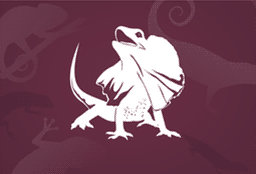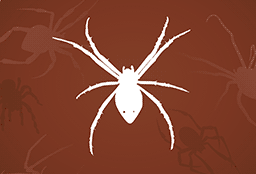Black and white, with the pattern varying across its range. The back of its neck, upper tail and shoulders (on its wings) are white in males and grey in females, and (across most of Australia) the rest of its body is black. In south-eastern, central and south-western Australia, including Tasmania, its back and rump are entirely white. Its eye is red-brown. Young birds are usually grey rather than black and have dark eyes.
Distinctive feature
One toe faces backwards and three face forwards. It has a square-tipped tail.
Olive brown to black and has irregular pale bands on the body and tail. The head is often lighter in colour and can have orange flecks on the top and sides.
There are four subspecies with some variations:
- Eastern Bobtail (Tiliqua rugosa aspera) Similar to western bobtail but with a darker belly, larger body scales and a shorter fatter tail
- Western Bobtail (Tiliqua rugosa rugosa) Similar to eastern and northern but paler belly and longer tail, larger ear and pale irregular bands on the back
- Rottnest Island Bobtail (Tiliqua rugosa konowi) Yellow belly.
- Northern Bobtail (Tiliqua rugosa palarra) Similar to western bobtail with a smaller ear and usually no pale irregular bands on the back
Size
Total length 45cm.
The caterpillar (larva) is initially pale yellow with fine hairs, before turning green. It has narrow yellow lines on its body which are sometimes hard to see. The upper side of the butterfly (adult) is white with a black tip on its forewing (front wing) and a black patch on the front edge of its hindwing. A male has one black spot on its forewing, while a female has two black spots. Looking from underneath, the forewing is white with two black spots and the hindwing is yellow.
Size
Caterpillar about 3.5 cm; Butterfly up to 5 cm wingspan.
The Christmas Spider is known by several other names, most commonly Jewel Spider but also as Six Spined Spider or Spiny Spider.
Females have bright yellow and white patterns with a ring of black spines. Melanic females have the same shape but may be completely black. Males have smaller spines and have a yellow, brown, white and black pattern. Six spines protrude from the sides and bottom end of the abdomen.
Size
Females are larger at 7 mm, males are 4 mm.
The adult male has a bright-yellow underbody, olive-green back and wings, and a black head with a bright-yellow collar. Its throat is white, with a broad black band which separates it from the yellow breast. Its beak and legs are black. The adult female has grey upperparts with a pale olive tinge, and is pale grey below with a pale yellowish tinge. Its beak is dark brown and its legs are grey-brown. Both sexes have a red-brown eye. Juvenile birds are rufous above and below, and as they mature, gradually resemble a female, though they retain some rufous feathers in their wings.
Its head and upperparts are mostly dark grey, with a white eyebrow and throat, a narrow grey band across the upper breast and a creamy-buff belly. The feathers of its long tail have white edges and tips, and the tail is often fanned out.
Size
14 – 16 cm long
Deciduous tree, not native to Australia. Grows up to 15 m high and wide.
Leaves
Bright green, feathery and fern-like. Individual leaves are narrow and elliptic, 3 – 12 mm long and arranged either side of a 5 – 10 cm long stem. They turn yellow in autumn before falling from the tree.
Flowers
Blue-purple and trumpet-shaped, forming clusters that are 20 – 30 cm in diameter. Each individual flower is 2 – 3 cm long and about 1 cm wide. They are lightly fragranced and remain on the tree for about 2 months.
There are four stamens inside the flower which produce pollen, and also a staminode which doesn’t produce any pollen.
Predominantly pale tawny-orange with a heavy black border that encloses large white spots in the forewing. The inner leading edge of the forewing is deep red-brown. The underside is similar to the upper side but paler with narrower black margins. Males have a distinct patch of dark grey sex-scales on the upper side of the hindwing.
The caterpillars have three pairs of tentacles and yellow, white and black rings.
Size
7 - 8 cm wingspan.
A black and white bird, the pattern varies slightly between sexes. The male has a white eyebrow above a black horizontal eye-stripe, a black face and throat, while the female has a white face and throat, with a broad vertical stripe through the eye, and no white eyebrow. Both sexes have a thin white bill and black legs and feet. Juvenile Magpie-larks have a black forehead, white eyebrow and a white throat.
The moaning frog is a burrowing frog native to south-western Western Australia. This frog is quite rotund, with a large head and bulbous eyes.
Brown or slate back with irregular yellow patches. Males have large limbs but show no distinguishing sexual features.
Tadpoles
Densely mottled with black and gold. Have a red or gold vertebral stripe and curved lateral line.
The motorbike frog is a ground-dwelling tree frog found in Southwest Australia. It gets its name from the male frog's mating call, which sounds like a motorbike riding past and changing gears. Other common names are Moore's frog, the western bell frog, western green and golden bell frog, and western green tree frog.
Back is green with gold mottling (after basking in sunlight). Can be almost dark brown in colder conditions. The underside usually ranges from very pale green to light brown.
Tadpoles
Large translucent yellow with darker areas. As they develop they become darker with deep fins and a pointed tail tip.
Erect spreading dark green shrub. 0.2 – 1 m high.
Leaves
Long, narrow, oblong, blunt, dark green above with very recurved margins.
Flowers
Stalked, yellow flowers with 5 distinct petals. The stamens are all found on one side of the centre of the flower and look like a tiny hand of bananas.
The genus name Hardenbergia is named after Franziska Countess von Hardenberg and the species name comptoniana after Mary, 1st Marchioness of Northampton whose husband was Charles Compton.
Twining shrub or climber. Its size varies depending on supporting plants or structures it is growing on.
Leaves
Usually crowded, 3 and sometimes rarely 5 foliate. Leaflets are 4 – 6 cm long., and do not spread very widely. Size approximately 2–4 mm long and 1 mm wide, thick, concavo-convex (concave on both sides) and pointed at ends.
Flowers
Blue to purple and in some cases white. Typical pea shape consisting of 5 petals: the "standard", the "keel" (2 fused petals) and two "wings". Flowers are in an often drooping, elongate cluster.
The Oblong turtle (Chelodina oblonga) occurs in Northern WA and the Northern Territory. This species is also known as Southwestern snaked-neck turtle (Chelodina colliei) in southwest Western Australia.
The original specimen collected and given the name Chelodina oblonga is now thought to be from a species of long necked turtle found in northern WA and the Northern Territory, the Northern Long-necked turtle (Macrochelodina rugosa). The first specimen of the oblong turtle seen in southwest WA was originally classified as Chelodina colliei.
The carapace (upper shell) ranges in color from light brown to black. The olive to gray neck is thick, with blunt rounded tubercles. The head is large and flat with a protruding snout and an unnotched upper jaw.
Size
Adult Shell 30 - 40 cm long.
A colourful bird, the upper part of its back is bright green, merging to light blue on the lower part to its rump. Its tail is black, tinged with blue, and has two long central feathers (called streamers) that extend beyond the tip of the tail. Its forehead is blue-green and the top of its head is golden. A bold black eye-stripe runs from the base of its beak and is bordered below by a narrow blue line. Its chin is yellow, changing to chestnut on its throat, below which is a broad black band. It has a green breast, becoming paler on the belly and changing to light blue from the lower belly to the vent. It has a long, slim, curved black beak and its legs and feet are grey-black.
Young birds are generally duller and greener. They lack the black band across the lower throat and the long tail streamers.
Distinctive feature
The sexes differ in the length of their tail streamers: the male has longer, more slender streamers.
The male is unmistakable in full breeding varying from cobalt-blue in the east of its range to violet-blue in the west with a pale blue head. Wings and long tail are brown with a blue wash. In non-breeding plumage, called eclipse, he is very similar to the female, being pale brown above and white underneath although he retains the blue wash on wings and tail. The young look like the females.
Distinctive feature
The magnificent blue colour of the male.
Size
14 cm
The Latin name Nuytsia comes from Pieter Nuyts, a member of the Council of Dutch Indies and a 17th century explorer in South Western Australia.
Tree or shrub, up to 10 m high.
Leaves
Long thin leaves.
Flowers
Orange with more stamens than petals.
Metallic blue-black on top and light to dark grey on its breast and belly. Its forehead, throat and upper breast are rust in colour. It has grey legs and feet, and its eyes and bill are black. A young Welcome Swallow has shorter tail feathers than an adult and its forehead and throat are a creamy beige (instead of rust).
Distinctive feature
A deeply forked tail with a white band or row of spots on the long tail feathers.
The motorbike frog is a ground-dwelling tree frog found in Southwest Australia. It gets its name from the male frog's mating call, which sounds like a motorbike riding past and changing gears. Other common names are Moore's frog, the western bell frog, western green and golden bell frog, and western green tree frog.
Back varies from pale brown to dark chocolate with areas of deep green or olive, red colouration in the groin and hind limbs.
Tadpoles
Large, black with deep tail fins.
Also known as Cape Lilac. It reaches maturity when it is 6 – 10 years old and lives for about 20 years.
Deciduous tree, usually 10 – 15 m high but can reach 45 m in its natural environment. Its canopy is 6 – 8 m wide.
Leaves
Bright glossy green and oval in shape, 2 – 7 cm long and 1 – 3 cm wide. They are arranged either side of a 12 – 45 cm long stem and turn yellow in late autumn before falling from the tree in winter.
Flowers
Pale purple to white, star-shaped, forming clusters that are 10 – 20 cm long. Each individual flower is about 2 cm in diameter and consists of 5 petals. The flowers have a chocolate scent!
One of Australia's most widespread birds on mainland.Mostly black with a white belly and eyebrow. A young bird has paler, slightly rusty edges to its wing feathers.
Size
18 - 22 cm long (from head to tail)






